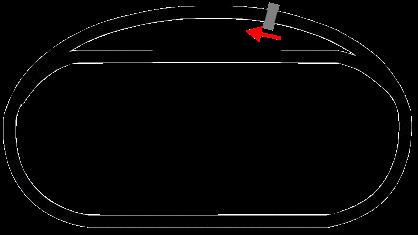Official name Capital City 300 | ||
 | ||
Date September 10, 1967 (1967-September-10) Course Permanent racing facility0.500 mi (0.800 km) Distance 300 laps, 150 mi (180 km) Weather Mild with temperatures approaching 75 °F (24 °C); wind speeds up to 12 miles per hour (19 km/h) | ||
The 1967 Capital City 300 was a NASCAR Grand National Series (now Monster Energy NASCAR Cup Series) event that was held on September 10, 1967, at Virginia State Fairgrounds in Richmond, Virginia.
Contents
The time of the race was two hours, thirty-six minutes, and ten seconds with the average speed being 57.631 miles per hour (92.748 km/h). The pole position spot was chosen by a random drawing; the rain that swept through the area had made the track far too muddy for qualifying sessions. Brooks drew the pole and the race was then started under green-yellow. The cars paced for 24 laps to help pack the clay; Richard Petty took over the lead on lap 25 to help bring about true racing.
Background
In 1953, Richmond International Raceway began hosting the Grand National Series with Lee Petty winning that first race in Richmond. The original track was paved in 1968. In 1988, the track was re-designed into its present D-shaped configuration
The name for the raceway complex was "Strawberry Hill" until the Virginia State Fairgrounds site was bought out in 1999 and renamed the "Richmond International Raceway". The Strawberry Hill Races, which are a series of steeplechase horse races were formerly held the third Saturday of April at the Richmond Raceway Complex. In 2001, the races were moved to Colonial Downs in New Kent County, Virginia's first Thoroughbred racetrack.
Summary
Richard Petty would defeat Dick Hutcherson after all the laps in the race were completed; which became the 71st win in his 200-win career as a Cup Series race. The other top ten finishers were: Paul Goldsmith, Sam McQuagg, James Hylton, Wendell Scott, Worth McMillion, E.J. Trivette, Henley Gray, and George Davis. There were twenty-eight American competitors and two Canadian competitors (Frog Fagan and Don Biederman). Econo Wash and Nichels Engineering were the main sponsors for the drivers. Most of the team owners in this race were individuals rather than multi-car teams; as the case usually was with NASCAR races prior to the mid-1970s.
Richard Petty would receive ($17,597.46 when considering inflation) $2,450 for winning the race while Don Biederman would be the lowest finishing driver (27th) to receive a prize bonus for $150 ($1,077.40 when considering inflation). The drivers who finished 29th and 30th (last place) would not receive any prize money. Total winnings for this race would be $11,610 ($801,653.86 when considering inflation).
Frog Fagan would make his official NASCAR Cup Series debut in this race. Eleven thousand fans would see a race with eleven cautions for seventy-one laps and three hundred laps were completed on a track spanning 0.500 miles (0.805 km). The transition to purposely-built racers began in the early 1960s and occurred gradually over that decade. Changes made to the sport by the late 1960s brought an end to the "strictly stock" vehicles of the 1950s; most of the cars were trailered to events or hauled in by trucks.
Finishing order
† signifies that the driver is known to be deceased
* Driver failed to finish race
